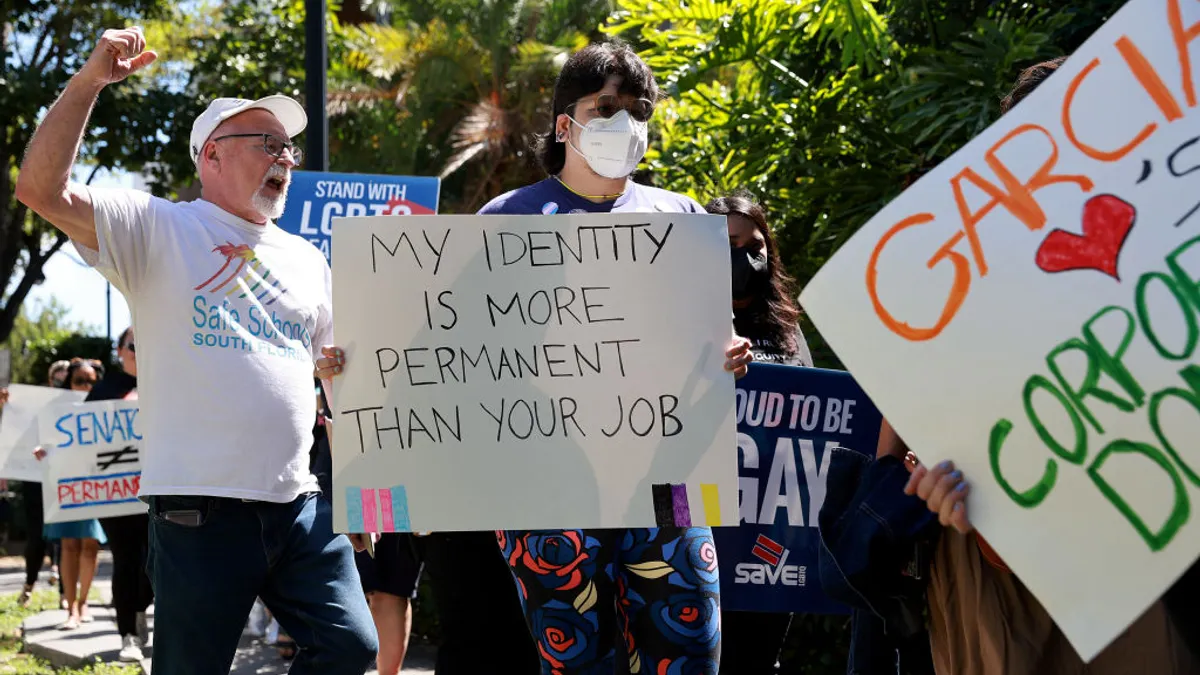In "Other Duties as Assigned," HR Dive editor Kate Tornone weighs in on employment trends, compliance best practices and, of course, the situations that require you to go above and beyond your normal duties. Today: tips and tricks to make your EEO-1 reporting just a little bit easier.
Employers dodged a bullet this year when the White House blocked looming EEO-1 compensation reporting requirements, but the survey's other reporting responsibilities remain (for businesses with at least 100 employees and certain federal contractors). And we’re well into the “snapshot period.”
You don’t actually have to file the form until March 31. And yes, I know you’ve got open enrollment and a million other things to worry about right now. But it’s only going to get worse from here on out: the new, later filing deadline puts it right in the middle of Affordable Care Act reporting deadlines, W2 filing requirements and more. Lucky you.
So do yourself a favor and at least consider whether you have everything that you need now. Addressing any potential problems today will ensure that you’re not rushing the process — and risking mistakes — in March. After all, the penalties for noncompliance can be steep, up to and including imprisonment for willful false statements.
Get self-identification data — or give it your best guess
One of the biggest challenges employers face with the EEO-1 is the self-identification piece. Employees don’t like sharing information about gender and race, according to Arthur Tacchino, chief innovation officer at SyncStream, a company that specializes in this and other types of reporting and compliance.
Ideally, the time to collect this info was yesterday — during each employee’s onboarding, to be specific. Requesting that data up front will save you from begging your entire company to complete a survey later. If it’s too late for that though, put a plan in place for the future and, for the 2017 report, “start doing it now,” Tacchino said. “The last thing you want to do is wait.”
And when you do ask employees for this info, be sure that your forms meet the U.S. Equal Employment Opportunity Commission’s (EEOC) requirements. The agency has strict rules about what can and cannot be on the form, but offers sample forms to help. It’s also important to make clear that providing this info is voluntary and that it won’t be used in any employment-related decisions, say attorneys at Epstein Becker & Green (EBG). And ensure that the collected information is directed to HR — not to the individual’s supervisor or manager, Susan Gross Sholinsky and Peter Stein recommended.
But what happens if the snapshot period is closing and you can’t get everyone to complete the survey? “If the employee does not complete the survey, you may take the information from any applicable existing employment records, and if none exist, make a best guess based on a visual observation of the employee,” Sholinsky and Stein said.
That’s right; you can just give it a guess. It’ll probably feel a little icky trying to guess your co-workers’ genders and races but even the EEOC prefers that to no information at all: The agency’s EEO-1 Frequently Asked Questions and Answers says that if an employee declines to self-identify, “employment records or observer identification may be used.” But remember, they must decline to self-identify — you can’t just guess for everyone to save time.
Hand pick your preferred time period
The EEOC requires you to base your reporting on one payroll period between Oct. 1 and Dec. 31. Want to make life a little easier on yourself? Figure out when you’ll have the fewest employees and use that window, recommends Tacchino. For many, this means you’ll want to use an early snapshot, to avoid including holiday hires.
The EBG attorneys agreed that this perfectly fine to do; fewer employees means less data, which means less work for you. On the other hand, however, “if your numbers look better during the busy holiday season, for example, you may wish to use that pay period,” they noted.
Cull pay data anyway
Yes, the Trump administration managed to halt pay reporting requirements for this year. But there are a few reasons why you may want to compile this information anyway. First, you need to know whether you can pull that data, Tacchino said.
There’s a chance the pay reporting requirements will come back in some form. Even the incoming Republican EEOC commissioners said they are committed to reworking those requirements. And if that data isn’t accessible, it’s better that you know now so you can put a process in place to capture it for next year, Tacchino said.
The EBG attorneys agreed, saying that while there’s no way to know whether you’ll have to report that data next year, a “test run” may be well worth your time.
In addition, having that info sets you up to do an internal pay audit. You can head off any potential pay discrimination claims by making any necessary adjustments; this can range from merely identifying employees who should possibly be up for a raise or promotion this year to — if you’re Salesforce — dropping $6 million to close your gender pay gap.
Sholinsky and Stein cautioned, however, that you have to be careful with this data. Depending on how you collect and use it, it won’t be privileged — meaning it could be discoverable if you’re sued. “As such, if employers choose to engage in a pay audit (and/or gather or analyze pay data), they should consider having their counsel involved to attempt to maintain the privilege,” the pair said.
Let technology do the heavy lifting
The EEO-1 isn’t overly complicated, but the sheer amount of data involved for some employers can be overwhelming, Tacchino said. Paper forms can leave a lot room for human error.
Instead of asking employees to self-identify on paper, an online survey can help you save time and avoid mistakes, Tacchino added. (He’s in that business, but there are a number of ways to go about this, including do-it-yourself options.) Other tech can also help you generate your report, which may be especially useful for large employers.
Get an extension
Is there just no way you’ll be ready by March 31? Request an exemption. But you’ve got to get the request in by the filing deadline.
To do so, you must email [email protected] with your company name, company number, address and contact information for the person responsible for the report.
And then, get filing!



















